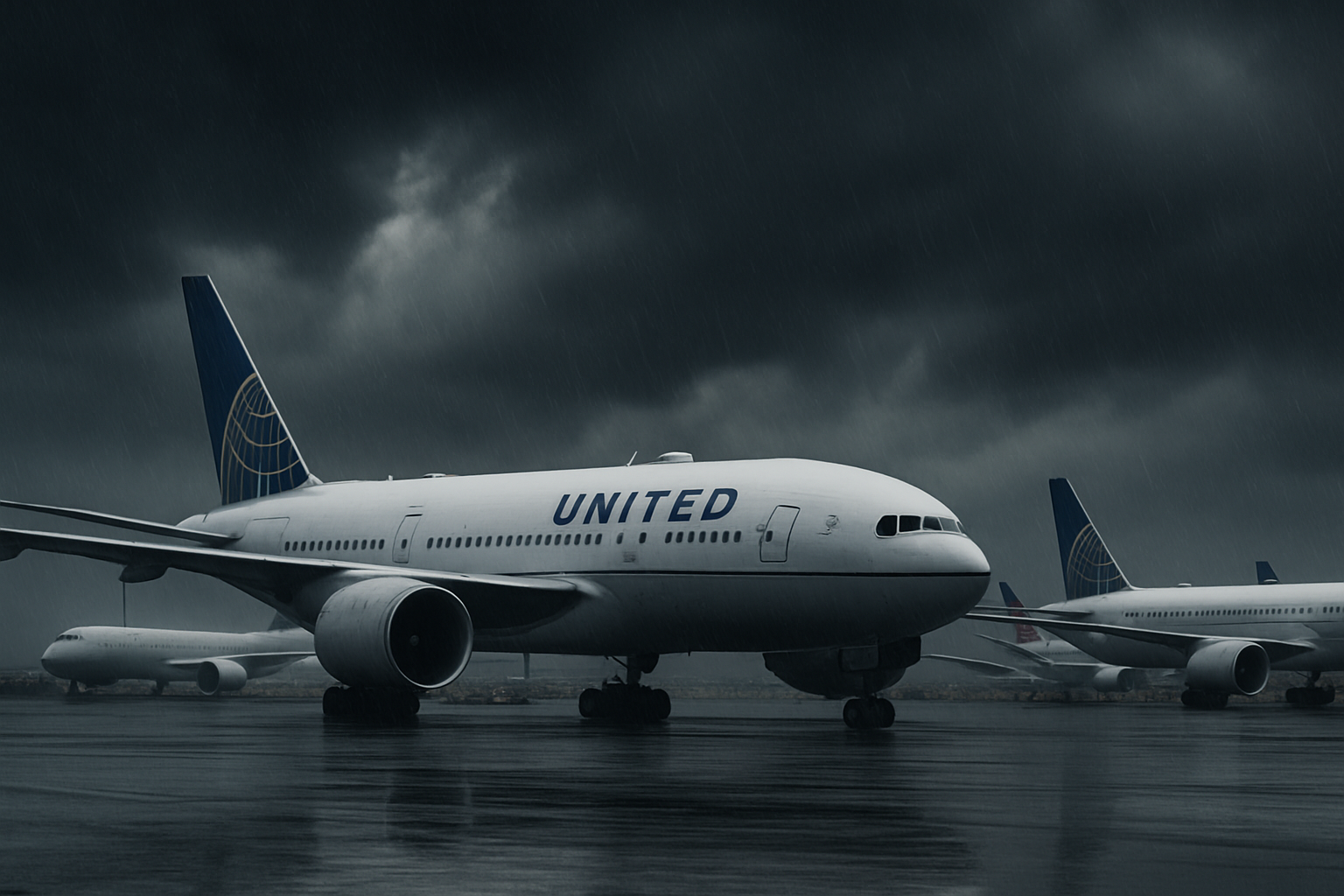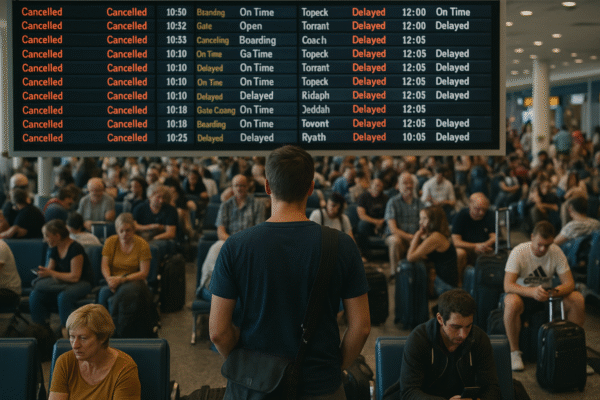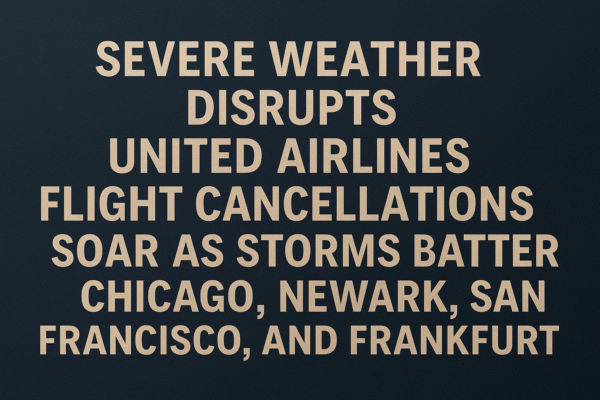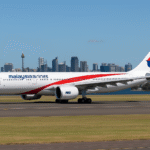United Airlines, one of the largest carriers in the United States, is grappling with widespread cancellations and delays after severe weather systems struck multiple regions across North America and Europe. Key hubs including Chicago O’Hare International Airport (ORD), Newark Liberty International Airport (EWR), San Francisco International Airport (SFO), LaGuardia Airport (LGA), Washington Dulles International Airport (IAD), and Frankfurt International Airport (FRA) in Germany have experienced major operational challenges, disrupting the travel plans of thousands of passengers.
The storm system brought thunderstorms, strong winds, fog, and heavy rain, resulting in at least 38 flight cancellations and 48 delays within the United Airlines network. While this represents around 1% of the carrier’s total schedule, the ripple effect across connecting flights has created significant bottlenecks.
Chicago O’Hare and Newark Liberty: The Hardest Hit
Among the affected hubs, Chicago O’Hare International Airport—United’s largest base—bore the brunt of the disruptions. With thunderstorms and high winds reducing runway visibility, the Federal Aviation Administration (FAA) initiated ground stops, preventing aircraft from taking off or landing safely. Passengers traveling between Chicago and destinations such as New York, Los Angeles, and London faced significant delays.
Similarly, Newark Liberty International Airport, a critical transatlantic hub, experienced cancellations on high-demand routes to Frankfurt, Paris, and London, as well as delays on domestic services to Atlanta, Miami, and Boston. The airport’s proximity to New York City amplifies the impact, as thousands of connecting travelers faced rebookings and extended waits.
Disruptions in San Francisco, LaGuardia, Washington Dulles, and Frankfurt
On the U.S. West Coast, San Francisco International Airport reported heavy delays due to dense fog and crosswinds along the Bay Area. This disrupted flights across the Pacific, including routes to Tokyo, Seoul, and Sydney, and stranded passengers connecting from Asia to other U.S. destinations.
In New York’s LaGuardia Airport, where runway limitations already constrain operations, strong crosswinds further complicated takeoffs and landings. Flights to domestic hubs like Chicago and Washington D.C. saw widespread cancellations.
Washington Dulles International Airport, a major gateway to Europe, faced heavy disruptions, especially on flights to London, Frankfurt, and Brussels. With connecting passengers reliant on Dulles for international itineraries, the storm created cascading effects across United’s global network.
Meanwhile, Frankfurt International Airport—one of United’s key European partners—experienced delays and cancellations on flights to the U.S. Midwest and East Coast. This stranded transatlantic travelers and underscored the storm’s impact on global tourism connectivity.
Passenger Experience: Long Lines, Missed Connections, and Frustrations
For passengers, the severe weather meant long queues at customer service desks, difficulty in securing rebooked itineraries, and uncertainty about when flights would resume. Many travelers took to social media to voice frustration about communication lapses and slow assistance.
United Airlines has waived change fees and offered rebooking options for affected passengers. For those stranded overnight, the airline has arranged hotel accommodations, meal vouchers, and shuttle services in line with Department of Transportation (DOT) guidelines.
Despite these measures, the sheer volume of disruptions left many travelers without immediate alternatives, especially those booked on international itineraries with limited availability. Families on holiday, corporate travelers on tight schedules, and tourists connecting to onward destinations all faced major inconveniences.
United Airlines’ Response and Recovery Efforts
United Airlines issued a statement apologizing for the widespread disruption and reaffirming its commitment to passenger safety as the top priority. The airline has urged travelers to check flight status updates via its mobile app and website before heading to airports.
The carrier is working with the FAA, European Air Traffic Control, and local airport authorities to safely resume operations. However, experts note that recovery from such weather-related disruptions can take several days, particularly given the complexity of United’s domestic and international connections.
The airline has also extended travel waivers for passengers affected by the storm, allowing them to rebook flights without additional charges.
Impact on Tourism and International Travel
The cancellations come at a critical time for global tourism. According to the U.S. Travel Association, summer travel demand in 2025 is expected to reach record highs, with millions of domestic and international visitors relying on major hubs like Chicago, New York, San Francisco, and Washington D.C.
Disruptions at Frankfurt International Airport, Europe’s busiest cargo and passenger hub, also have implications for tourism between Germany and the United States, two of the world’s largest travel markets. Stranded passengers in Frankfurt reported difficulties rebooking flights due to high demand on limited transatlantic routes.
Looking Ahead: Weather Challenges and Airline Preparedness
Meteorologists predict that stormy weather patterns will persist across the U.S. Northeast and parts of Europe throughout the week, raising the possibility of further cancellations. United Airlines, along with other carriers, will need to maintain flexible operations and prepare for additional passenger assistance demands.
Travel analysts suggest that airlines will continue to face increasing climate-related disruptions, making investment in resilient scheduling systems, improved passenger communication tools, and real-time rebooking technology more important than ever.
Conclusion
The severe weather disruptions at Chicago O’Hare, Newark Liberty, San Francisco, LaGuardia, Washington Dulles, and Frankfurt International Airport highlight the vulnerability of global aviation to natural forces. United Airlines has implemented emergency measures to assist stranded passengers, but the ripple effect of cancellations underscores how quickly a storm can unravel carefully planned travel itineraries.
For travelers, the key takeaway is clear: always check flight status, use airline apps for updates, and plan for contingencies when traveling during storm-prone seasons. As United Airlines works to restore normal operations, the event serves as a reminder of both the fragility and resilience of the global tourism ecosystem.
For more travel news like this, keep reading Global Travel Wire
















